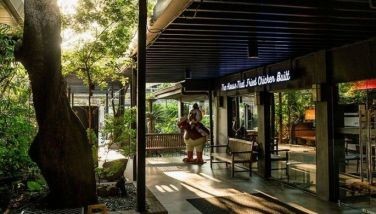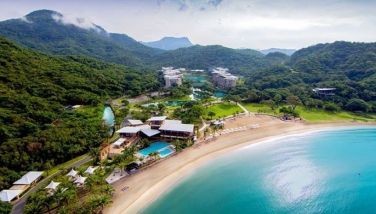A journey with a friend through Bhutan
November 9, 2003 | 12:00am
 We are traveling together again.
We are traveling together again.
It is Saturday. Clovis and I are moving out of Mongar township, 450 kilometers from Thimphu, the country’s capital. He arrived early morning when it was still dark and raining. The dog pack that guards the garbage dump became unusually silent at the moment he entered my dream.
Clovis and I are moving towards Lingmethang where the climate is almost tropical, where I once spotted a hornbill during my first visit to Bhutan, where banana trees grow in full view of the greater Himalayas. I point out to him the ruins of the old dzong, the fortress that once guarded the valley. The jungle has overwhelmed its ramparts.
We gather some samples of the flowering sarpagandha plant at the demonstration plots of the government district farm. The sarpagandha, our agronomist friend claims, has aromatic qualities and medicinal attributes. He also shared with us several grams of grounded shirata from his personal stash of herbal cures. Clovis keeps smiling, his head slightly tilted to one side, as we get instructions on its use. This might have something to do with becoming a shaman.
Clovis is alerted by one of our traveling companions to the fragrance of flowering walnut trees as our vehicle moves to higher elevation. Then a family of langurs, long-tailed monkeys with a bush of spiked hair around their faces, greeted us from a tree by the roadside. They spy at us curiously and cautiously. We stop right in front of their tree. The langurs stare at us and we at them. We seem totally surprised that no fear exists between us. As we leave the scene, I inform Clovis that the Bhutanese traveler considers it a lucky sign to encounter this kind of monkey at the beginning of a journey.
All along the narrow route are patches of yellow and violet flowers. We pass by two streams, each guarded by a solitary bird. The slopes start to become thick and green with coniferous forests. They could be hemlock and blue pine, but names are not important here. When confronted by these tall mountains and deep valleys, it is enough to be in their presence. It is almost like the ocean commanding you to be speechless and to behold.
We are tempted to reminisce of our Bohol: tuba and mangrove swamps; kinilaw and the crossing from Sandingan to Cabilao Island; sugba and the persistence of Dagohoy’s resistance; kinampay and the duel between the wizard Tamblot and the Spanish friar...
But the weather gets colder as we climb higher towards Thrumsingla Pass. Swifts with white-tips on their tails weave imaginary maps at the edge of cliffs. We are approaching Namling. The place is prone to landslides, the ravines steep, rugged and deep. Every time people travel this way, they pray that rain will not transform soil to mud and loosen boulders from their precarious locations. Some travelers bring sleeping bags in case bulldozers are not available to deal with the landslide plugging the route. That means sleeping overnight in one of the houses thinly dispersed along the road or making the long and cold vigil inside the vehicle. Others prepare for the trip through Namling by bringing along plastic bowls of instant noodles, to stay their hunger while waiting for the roadblock to be cleared.
Clovis now realizes that it takes two days and one night to travel from the eastern part of the country, where we started, to Thimphu, the capital. Somehow this reminds me of the passenger buses in Bohol that put up a sign, just behind the windshield, to indicate where it will stop overnight during a long journey. The most familiar to us, because the bus passed by Loon, the hometown of Clovis, was "Sleep Talibon".
But there is something different about this place, I confide to him. Not long ago, this year, a family of four from Kanglung and their neighbor, riding a blue and weathered Land Cruiser, were on their way to Bumthang to join the gathering of Buddhist devotees intent on getting the blessing of a visiting Rimpoche from India. They were passing Namling. The vehicle’s engine went dead and slid backwards towards the edge of the cliff. The neighbor died. The wife of the driver was badly hurt and might never walk again. We were a bit shaken by what happened because we live in the same community as the victims.
In 1998, a bus with about 58 passengers, after negotiating a curve, plunged down the mountain. Yes, also in Namling. More than 40 people died. One of the survivors was a child who was barely one year old. Both his parents were among the fatalities. This boy now lives with his uncle in Kanglung. I met him during an office picnic in a small pasture area somewhere in Khaling. The scent of manure mixed with pinewood was overpowering. His uncle and aunt, with whom I work in an agriculture program, told me his story. A chorten, that Bhutanese landmark and monument built on consecrated grounds, now stands where the bus made the tragic fall. The person driving our vehicle is the boy’s uncle.
Clovis notices a waterfall, then another, and another. There’s a large one that drops from a hundred meters, very near the road. The rushing and crashing sound among debris of tree trunks, branches and stones always leaves an impression on passers-by. There’s one that floods a portion of the road. Another one that flows through a huge culvert beneath the road runs swiftly through a punctured boulder where stands on top a chorten with prayer flags, and finally surges magnificently down a ravine to nowhere. Namling connotes danger, even death, but it abounds with waterfalls. The area is just a portion of the enormous wilderness known as Thrumsingla Park. Not far away is the Pass, the highest road point in the country at 3,750 meters above sea level. This is home of the red panda, the monal pheasant whose feathers are used to quiver traditional arrows, the leopard that is known to hunt dogs in distant villages, countless species of fascinating birds. The place is alive, full of untamed spirits just like the poetry of Clovis, just like the etheric double of Bohol that we secretly celebrate.
Those who died in Namling could now be guarding the waterfalls or have become waterfall. I tell Clovis that I got this kind of feeling when I touched a weeping cypress in Lhuntse district. The cypress trees are found in many holy places in Bhutan, ancient and towering and full of silence. Some say that Buddhist lamas and saints planted them.
I am reminded of the gigantic balite trees, three of them, clustered at the boundary of Tagbilaran and Baclayon. I was standing dumbstruck at the foot of these awesome trees with sprawling branches, tendrils hanging everywhere and the leaves just kept falling. The tambalan, the local shaman, who was performing a rite with offerings of coconut wine and tobacco, would later tell us that he saw cows, goats and pigs entering one of the trees. It was my first visit to Bohol island.
It is very possible that after death, depending upon circumstances, a person blends with a river or stream, an oak tree or a forest–becomes Nature. I tell Clovis that he can transmute to "Tubig Loon", that particular coastal spot in his hometown where fresh water mates with the sea. He can become the spirit guarding the marshland at the mouth of Abatan River, that sanctuary which we dearly fought to conserve and where our friend-ship gained energy. He can have a commanding view of the entire area from the cliff in Cortez town, known as "Larga Vista." Or he can become the elusive lighthouse keeper in Cabilao Island.
I switch on the radio and turn the dial to BBS, the Bhutan Broadcasting System. There is chanting, a gurgling brook of prayers, emanating from the speakers. Our traveling companions inform us that only prayers and religious commentaries are being aired till the royal grandmother is cremated, 49 days after her death. Her Majesty Gayum Phunstho Choden passed away on August 24 in her retreat residence at the outskirts of Thimphu. She was 92. During her reign, we were told, many Buddhist lakhangs (temples), shedras (monasteries), and drubdeys (meditation centers) were either renovated or constructed. She was like a spiritual power behind the throne, quietly supporting the unity of the Buddhist sects and the resurgence of Buddhism as Bhutan opened its doors to a globalized world. I invite Clovis to join our family when we pay our respect to the royal grandmother and offer the white scarf of everlasting peace.
Clovis hesitates, not really keen about staying longer in Bhutan. So I tell him about the former Je Khempo, the Buddhist lama holding the highest religious office in the land. Many stories have been said about how he died while in lotus posture. He must have been in his 80s. For many days people came to view the remains of this holy man in the yogic position of meditation. He was not cremated but entombed in a chorten.
Clovis is not impressed. I recount to him the story of Phuntsho, the prime carpenter of Narang village in Mongar district. He was selected unanimously by the folks to go to Thimphu and help construct the grand chorten in memory of the former King Jigme Dorji Wangchuk. Some months after coming back to his village, he had an altercation with his daughter-in-law who was living in the same household with his family. Phuntsho felt so bad about the incident that he wandered off to the forest to ponder. He never returned. The villagers sent out parties to look for him, but in vain. After a month, the villagers decided to send a delegation to the Rimpoche of Ramshikar, the high lama who is said to have a gift of seeing through time and space, to ask his advice on how to find Phuntsho. The Rimpoche told the group of people from Narang that upon their return to the village they would meet a stranger who holds the answer.
Two weeks after, a man who had been in the forest gathering the dried shells of insects that are used to produce red dye, appeared. He told them that not far away, in a treacherous part of the jungle, he saw some scattered items that might belong to the lost victim. The stranger presented the personal articles to the villagers; indeed, they belonged to Phuntsho. By all indications, Phuntsho was taken away by a large animal, most probably one of the tigers that roam the thick and unpredictable wilderness of Mongar.
A sparkle in Clovis’ eyes. We could go on for hours piecing to each other fragments of the real puzzles of our imagination. That’s how we melted the hours away in Bohol: recollecting stories and haunting new places. If he stays longer in Bhutan, we can gather more tales and believe in the Yeti.
We can even join the Brokpas, those free-roaming communities of yak herders, who would cross to Tibet to barter rare herbs for porcelain. I met them once wintering in Khaling, with their big black mastiffs and their portable households. I tell Clovis that only the Brokpas treat the Yeti with awed respect. In their sub-alpine homeland, they could still be practicing the rite of sky burial. We could go there some day, I say … but Clovis yearns to go home. He misses his family. I miss his company.
Once upon a time, we were in the town market of Loon drinking tuba, coconut wine made horribly red by mangrove bark. We were among Clovis’s friends: fishermen who brought the meat of giant clams to whet our appetite; farmers who might as well be rebels; operators of masiao, the local numbers game. We moved from tipsy to drunken happy, carousing as if it was the eve of festivities of our patron saint. Then all of a sudden Clovis announced that he would bring me to Tagbilaran in his trail bike. It was about 8 at night.
The trip would take more than an hour; the road was rough and the route stricken by darkness. It started to rain. There was a brief commotion, a debate whether we should go or not, if it was worth the risk. Clovis prevailed. And so off we flew through the night, the beam of a single headlight ahead of us. The rain needled our faces. Clovis was driving by intuition and I was the fearless rider. To distract the cold we shouted political slogans. We slowed down to recall and exchange broken passages of poetry. And we were very quiet when we crossed Maribojoc to Cortez, eyes and hearts absorbing the Abatan marshlands.
When we resumed breakneck speed, Clovis and I already knew what we always left unspoken: That we can become the sky, the land and sea we so dearly love. Nothing can happen to us. We can go on and on. When we die, the light in the wilderness will redeem us.
BrandSpace Articles
<
>
- Latest
- Trending
Trending
Latest














